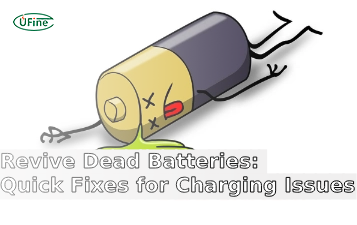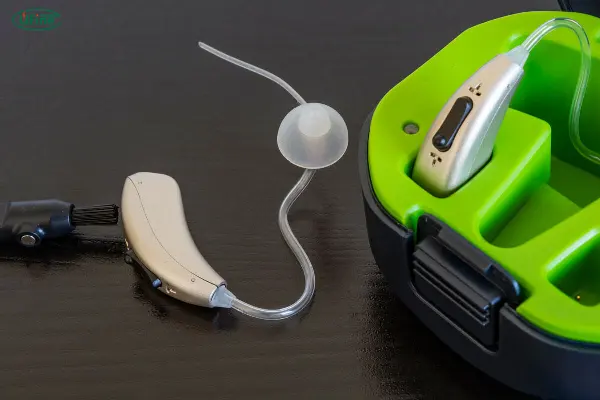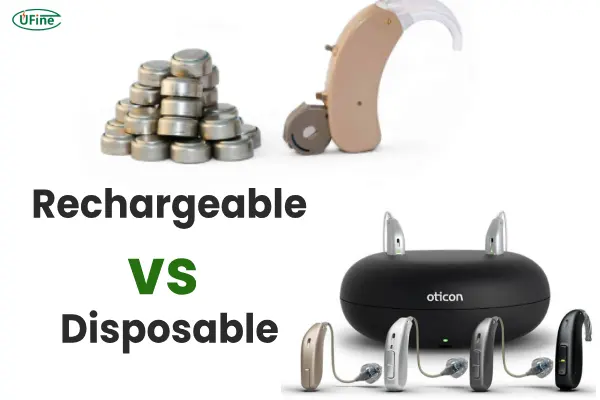
- Part 1. Rechargeable hearing aid batteries size
- Part 2. Rechargeable hearing aid batteries voltage
- Part 3. Rechargeable hearing aid batteries chemical type
- Part 4. How much power do you need?
- Part 5. Comprehensive comparison: rechargeable vs. disposable
- Part 6. How long can rechargeable hearing aid batteries last?
- Part 7. How long does it take to charge hearing aid batteries?
- Part 8. Advanced maintenance and troubleshooting
- Part 9. Purchasing guide: 7 essential considerations
- Part 10. Final thoughts
- Part 11. FAQs
Rechargeable hearing aid batteries have changed the way people manage their hearing devices. Instead of constantly buying and replacing disposable batteries, users can now charge their devices overnight and enjoy a full day of hearing support. But this shift brings new questions. The most common one? “How long can rechargeable hearing aid batteries last?”
In this comprehensive guide, we’ll walk through everything you need to know about rechargeable hearing aid batteries—battery size, voltage, chemical type, charging time, care tips, and more. Whether you’re a longtime hearing aid user or exploring rechargeable options for the first time, this guide offers detailed, practical answers.
Part 1. Rechargeable hearing aid batteries size
The size of a hearing aid battery impacts more than just how long it lasts on a single charge. It also affects the design, weight, and wearability of the hearing aid. Most rechargeable batteries used in modern hearing aids are built directly into the device. These battery sizes don’t follow traditional zinc-air size codes like 10, 13, or 312. Instead, they are:
-
Custom lithium-ion battery packs: Compact and integrated
-
Size 13-compatible lithium batteries: Found in hybrid models
-
Micro rechargeable modules: Used in ultra-miniature in-the-ear (ITE) designs
Rechargeable hearing aid batteries come in three primary sizes, each designed for specific device types and usage requirements:
-
Size 10 (Yellow)
-
Dimensions: 5.8mm diameter × 3.6mm height
-
Typical capacity: 50-60mAh
-
Best for: Completely-in-canal (CIC) and invisible-in-canal (IIC) devices
-
Average runtime: 16-20 hours
-
-
Size 312 (Brown)
-
Dimensions: 7.9mm diameter × 3.6mm height
-
Typical capacity: 170-200mAh
-
Best for: Receiver-in-canal (RIC) and behind-the-ear (BTE) models
-
Average runtime: 22-30 hours
-
-
Size 13 (Orange)
-
Dimensions: 7.9mm diameter × 5.4mm height
-
Typical capacity: 280-310mAh
-
Best for: Power BTE hearing aids
-
Average runtime: 30-36 hours
-
Generally, larger batteries offer more power but add bulk. Smaller models might be sleeker, but they may need more frequent charging.
-
Custom lithium-ion battery packs: Compact and integrated
-
Size 13-compatible lithium batteries: Found in hybrid models
-
Micro rechargeable modules: Used in ultra-miniature in-the-ear (ITE) designs
Part 2. Rechargeable hearing aid batteries voltage
Modern rechargeable hearing aid batteries operate within specific voltage ranges that directly affect performance:
-
Nickel-Metal Hydride (NiMH): 1.2V nominal voltage
-
Discharge curve: Maintains stable 1.2V for 80% of capacity
-
End-of-life voltage: ~1.0V
-
-
Lithium-Ion (Li-Ion): 3.7V nominal voltage
-
Discharge curve: Gradual decline from 4.2V to 3.0V
-
Built-in voltage regulation in most hearing aids
-
Important Note: Some hearing aids automatically adjust performance based on battery voltage. Li-Ion batteries typically provide more consistent sound quality throughout their discharge cycle.
Higher voltage batteries, such as lithium-ion, maintain consistent output even as they approach the end of their charge. This results in fewer audio dropouts and better signal quality throughout the day.
Part 3. Rechargeable hearing aid batteries chemical type
The chemistry inside a battery determines how much energy it can store, how long it will last, and how safe it is.
Nickel-Metal Hydride (NiMH)
-
Older technology
-
Lower energy density
-
Slower charge/discharge cycles
-
Shorter lifespan (1–2 years)
Lithium-Ion (Li-ion)
-
High energy density
-
Long cycle life (up to 1,000 charges)
-
Faster charging
-
Lighter and more compact
Silver-Zinc
-
High voltage output
-
Stable discharge rate
-
Less common, and more expensive
Ufine Battery—a trusted Chinese custom lithium battery manufacturer—offers a full range of options for manufacturers and tech developers. We specialize in lithium polymer, LiFePO4, 18650, and other cylindrical batteries. Our catalog includes ultra-thin, high-rate, and high/low-temperature batteries. Every battery can be customized to your specific size, voltage, capacity, or discharge rate needs.
Reach out to Ufine Battery for premium, customized rechargeable battery solutions.
Part 4. How much power do you need?
To determine your ideal battery capacity, consider these factors:
-
Daily Usage Patterns
-
Light use (8-12 hours): 150-200mAh
-
Moderate use (12-16 hours): 200-250mAh
-
Heavy use (16+ hours): 250-300mAh
-
-
Feature Utilization
-
Bluetooth streaming: +20-30% power consumption
-
Noise reduction: +10-15% power consumption
-
Directional microphones: +5-10% power consumption
-
-
Environmental Factors
-
Cold weather: +15-25% power requirement
-
Humid conditions: +5-10% power requirement
-
High background noise: +10-20% power requirement
-
Most users will need a battery that supports at least 16 hours of usage on a single charge. However, if you rely heavily on streaming or use complex noise filtering, aim for higher capacity models that can provide up to 30 hours.
Part 5. Comprehensive comparison: rechargeable vs. disposable
Five-Year Cost Analysis
| Battery Type | Initial Cost | Annual Cost | 5-Year Total | Environmental Impact |
|---|---|---|---|---|
| Premium Disposable | $0.80/ea (4/day) | $1,168 | $5,840 | 7,300 batteries |
| NiMH Rechargeable | $40 (battery) + $30 (charger) | $40 (replacements) | $240 | 2-4 batteries |
| Li-Ion Rechargeable | $100 (battery) + $50 (charger) | $25 (replacements) | $175 | 1-2 batteries |
Performance Comparison
| Metric | Disposable Zinc-Air | NiMH | Li-Ion |
|---|---|---|---|
| Runtime | 5-7 days | 18-24 hours | 24-36 hours |
| Voltage Stability | Excellent | Good | Excellent |
| Cold Weather Performance | Poor | Fair | Good |
| Convenience | Moderate | High | Highest |
Professional Recommendation: For users with dexterity challenges or active lifestyles, rechargeable systems often provide greater independence and reliability.
Part 6. How long can rechargeable hearing aid batteries last?
When people ask how long a rechargeable battery lasts, they usually mean two things:
a. Daily Runtime (Per Charge)
-
Lithium-ion: 16–30 hours
-
NiMH: 8–14 hours
b. Battery Lifespan (Before Replacement)
-
Lithium-ion: 2–5 years
-
NiMH: 1–2 years
The battery will gradually lose capacity over time. When it stops lasting through the full day or takes longer to charge, it’s time for a replacement.
Part 7. How long does it take to charge hearing aid batteries?
Modern Charging Systems
-
Standard Chargers
-
Charge time: 3-6 hours (NiMH), 2-4 hours (Li-Ion)
-
Basic LED indicators
-
Suitable for overnight charging
-
-
Fast Chargers
-
Charge time: 1-2 hours (Li-Ion only)
-
Temperature monitoring
-
Automatic shutoff
-
-
Portable Chargers
-
Compact power bank designs
-
1-2 full charges on the go
-
USB-C compatibility
-
Optimal Charging Routine:
-
Charge nightly, regardless of remaining capacity
-
Remove from charger once full (for NiMH)
-
Clean charging contacts weekly with alcohol wipes
Safety Warning: Never attempt to modify or repair damaged batteries. Swollen or leaking batteries should be replaced immediately.
Part 8. Advanced maintenance and troubleshooting
Monthly Maintenance Checklist
-
Contact Cleaning
-
Use 90% isopropyl alcohol
-
Gently wipe with cotton swab
-
Allow to dry completely
-
-
Performance Test
-
Note runtime between charges
-
Monitor any sound quality changes
-
Check for unusual heat during charging
-
-
Storage Preparation
-
For seasonal devices, charge to 50%
-
Store in airtight container
-
Include silica gel packet
-
Common Issues and Solutions
| Problem | Possible Cause | Solution |
|---|---|---|
| Short runtime | Old battery, cold weather | Replace battery, keep warm |
| Won’t charge | Dirty contacts, faulty charger | Clean contacts, try different charger |
| Overheating | Defective battery, wrong charger | Discontinue use, replace battery |
Professional Insight: Many hearing aid clinics offer free battery testing services to help determine when replacement is needed.
Part 9. Purchasing guide: 7 essential considerations
-
Compatibility Verification
-
Check hearing aid manufacturer specifications
-
Verify physical dimensions
-
Confirm voltage requirements
-
-
Capacity Requirements
-
Match to your daily usage
-
Consider future needs
-
Account for environmental factors
-
-
Brand Reputation
-
Look for medical device certifications
-
Check independent lab tests
-
Read professional reviews
-
-
Warranty Coverage
-
Minimum 1 year for NiMH
-
2-3 years for Li-Ion
-
Clear replacement policies
-
-
Charger Quality
-
Overcharge protection
-
Status indicators
-
Build quality
-
-
Vendor Reliability
-
Authorized dealers
-
Return policies
-
Customer support
-
-
Future-Proofing
-
Upgradability
-
Technology trends
-
Manufacturer support lifecycle
-
Specialist Recommendation: For unique requirements, consider custom solutions from manufacturers like Ufine Battery, who can tailor batteries to specific size, capacity, and performance needs
Part 10. Final thoughts
Rechargeable hearing aid batteries bring real benefits—longer use times, reduced waste, and easier daily management. Still, to get the most out of them, it helps to understand how they work, how to maintain them, and when to replace them.
For hearing aid brands and OEM developers, sourcing the right battery can be a challenge. That’s where Ufine Battery comes in. We are a leading lithium battery manufacturer in China, offering a complete catalog of:
-
Lithium polymer batteries
-
LiFePO4 batteries
-
18650 and cylindrical cells
-
Ultra-thin, high-rate, and temperature-resistant batteries
Ufine customizes batteries for specific voltage, capacity, and size requirements, making them a perfect partner for personal audio tech, hearing aids, and wearables.
Reach out to Ufine Battery today to explore solutions designed for your unique power needs. Hearing should be effortless. Powering it should be too.
Part 11. FAQs
Can I replace the rechargeable battery myself?
Most rechargeable hearing aids have sealed batteries. You’ll need professional help to replace them.
How will I know when my battery is wearing out?
You’ll notice shorter runtimes and longer charging times.
Are rechargeable batteries safe for air travel?
Yes. Lithium batteries are allowed in carry-on bags. Keep the charger with you.
Can I overcharge my battery?
Modern chargers stop charging when full, but it’s still best to unplug when done.
What if I forget to charge my battery?
Some devices offer quick-charge modes. Keep a portable charger on hand just in case.
Related Tags:
More Articles

How to Revive Dead Batteries and Fix Lithium Batteries that Won’t Charge?
Learn how to safely revive a dead lithium-ion battery, troubleshoot charging issues, fix lithium battery problems, and extend battery life.
LiPo Battery Charge Rate Calculator
Calculate safe LiPo, Li-ion, and LiFePO4 battery charging times and rates. Prevent overcharging, extend life, and optimize performance.
4.0Ah vs. 2.0Ah Battery: Key Differences and Which is Best for Your Projects
Compare 2Ah vs 4Ah batteries: meaning, runtime, weight, and best tool uses. Learn if 4.0Ah is worth it for your cordless tools and DIY projects.
How Long do Lithium Batteries Last?
Learn how long lithium batteries last, their life expectancy, cycle life, and tips to extend lithium-ion battery lifespan effectively.
Lithium Battery Temperature Range: Everything You Need to Know
Learn optimal lithium battery temperature ranges for use and storage. Understand effects on performance, efficiency, lifespan, and safety.




